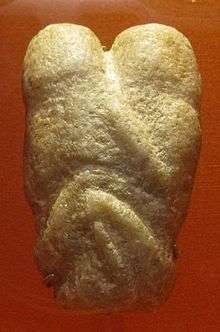Ain Sakhri Lovers
| Ain Sakhri Lovers figurine | |
|---|---|
 | |
| Material | stone (calcite cobble) |
| Size | 102 mm high |
| Created | 9000 BCE |
| Discovered | in Ain Sakhri caves, Wadi Khareitoun near Bethlehem |
| Present location | British Museum, London |
| Identification | 1958,1007.1 |
The Ain Sakhri Lovers figurine is a sculpture that was found in one of the Ain Sakhri caves near Bethlehem.[1] The sculpture is considered to be 11,000 years old and to be the oldest known representation of two people engaged in sexual intercourse.[2]
Discovery
The sculpture was identified in 1933 by René Neuville, a French consul in Jerusalem[3] and prehistorian, when looking through random finds obtained by the French Fathers at Bethlehem. He found the stone whilst visiting a small museum with Abbé Breuil.[4] Neuville immediately identified it as important and was able to get an introduction to the Bedouin who had made the finds at Wadi Khareitoun. He was led to a location within the Ain Sakhri caves and it is from these caves that the sculpture gets its name. Excavations of the caves revealed that the cave had been used domestically thousands of years ago and the finds were Natufian. For this reason it is thought that the figurine was used domestically and had not been left there as part of a funeral.[1]
The person who made the sculpture came from the Natufians, an early Epipaleolithic culture whose members are thought to be the first humans to gather grass seeds that remained attached to their stems.[2] This is an important step in agriculture as it eventually allowed farmers to choose which seeds to eat and which to keep to sow the following season.[4] These people hunted gazelle and are the first known to domesticate dogs,[5] sheep, and goats which also involves selective breeding. It has been speculated that the stability of having a managed food programme allowed the Natufians to create large communities of two to three hundred people and to create art.[4]
Appearance
The sculpture was made by carving a single "calcite cobble" which was picked away with a stone point to identify the position of the couple.[1] Although it lacks details, such as faces, it is considered to be a clever piece of sculpture. Artist Marc Quinn has noted that the figure looks different depending on the viewer's perspective, and may resemble a couple, a penis, breasts, or a vagina depending on this perspective,[2] or two testicles when viewed upside-down, from the bottom. Quinn compared it to a modern pornographic film where the action may include close-ups and long shots. It is clear that the figures in the couple are facing each other, but the gender of the figures can only be presumed.[6]
Importance and purchase
After the death of René Neuville in 1952, it was purchased by the British Museum at Sotheby's in 1958 from M. Y. Neuville.[6]
The object formed the basis of an episode of A History of the World in 100 Objects, a BBC radio programme in January 2010 about the dawn of agriculture.[4]
See also
References
- 1 2 3 "British Museum - Ain Sakhri lovers figurine". 2011-08-11. Retrieved 2018-09-12.
- 1 2 3 A History of the World -7, BBC.co.uk, accessed July 2010
- ↑ Neuville represented the French Republic as vice-consul at Jerusalem from 1928 to 1937 and as consul-general from 1946 to 1952; see footnote on page 301 of Les Mandats Francais Et Anglais Dans Une Perspective (in French); he is known for his work with Skhul and Qafzeh hominids in the Levant.
- 1 2 3 4 A History of the World in 100 objects - Part 7, BBC Radio 4, 26 January 2010, transcript, accessed 23 July 2010
- ↑ Clutton-Brock, Juliet (1995), "Origins of the dog: domestication and early history", in Serpell, James, The domestic dog: its evolution, behaviour and interactions with people, Cambridge: Cambridge University Press, ISBN 0-521-41529-2
- 1 2 figurine, British Museum, accessed July 2010
Bibliography
- B. Boyd and J. Cook, 'A reconsideration of the "Ain Sakhri" figurine', Proceedings of the Prehistoric Society, 59 (1993), pp. 399–405
External links
| Preceded by 6: Bird-shaped pestle |
A History of the World in 100 Objects Object 7 |
Succeeded by 8: El-Amra clay model of cattle |